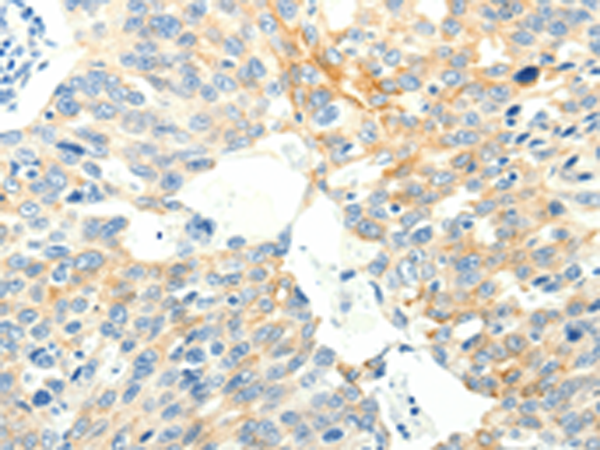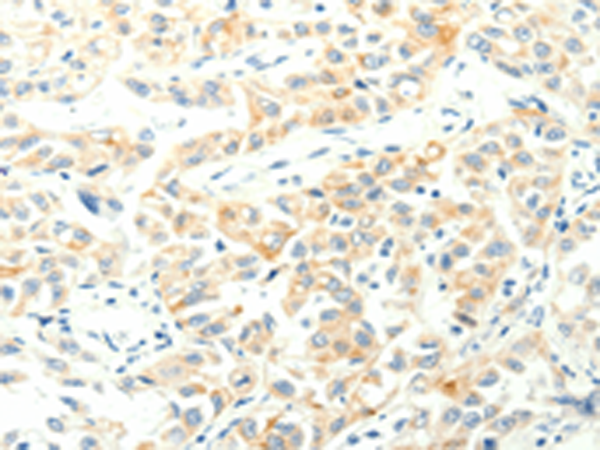

| WB | 咨询技术 | Human,Mouse,Rat |
| IF | 咨询技术 | Human,Mouse,Rat |
| IHC | 1/25-1/100 | Human,Mouse,Rat |
| ICC | 技术咨询 | Human,Mouse,Rat |
| FCM | 咨询技术 | Human,Mouse,Rat |
| Elisa | 1/2000-1/5000 | Human,Mouse,Rat |
| Aliases | MAP126; DEEPEST; hMAP126 |
| Host/Isotype | Rabbit IgG |
| Antibody Type | Primary antibody |
| Storage | Store at 4°C short term. Aliquot and store at -20°C long term. Avoid freeze/thaw cycles. |
| Species Reactivity | Human, Mouse |
| Immunogen | Fusion protein of human SPAG5 |
| Formulation | Purified antibody in PBS with 0.05% sodium azide and 50% glycerol. |
+ +
以下是关于SPAG5抗体的3篇参考文献的示例(注:部分信息为模拟概括,建议通过学术数据库核实具体文献):
1. **文献名称**: *SPAG5 promotes cell proliferation and inhibits apoptosis in human hepatocellular carcinoma*
**作者**: Li, X. et al.
**摘要**: 该研究利用SPAG5抗体通过免疫组化(IHC)和Western blot检测SPAG5在肝癌组织中的表达,发现其高表达与肿瘤增殖相关,并通过调控Cyclin B1影响细胞周期。
2. **文献名称**: *SPAG5 as a prognostic biomarker in breast cancer: correlation with clinical outcomes*
**作者**: Huang, Y. et al.
**摘要**: 研究采用SPAG5抗体对乳腺癌组织进行染色,发现SPAG5高表达与患者生存率降低和化疗耐药性显著相关,提示其作为预后标志物的潜力。
3. **文献名称**: *Mechanistic role of SPAG5 in regulating mitotic progression and chromosomal stability*
**作者**: Zhang, R. et al.
**摘要**: 通过SPAG5抗体介导的免疫荧光和Co-IP实验,揭示了SPAG5在维持有丝分裂纺锤体完整性中的作用,并证明其缺失导致染色体异常分离。
如需具体文献,建议在PubMed或Web of Science中检索关键词“SPAG5 antibody”或“SPAG5 immunohistochemistry”。
SPAG5 (Sperm-associated antigen 5), also known as SPATA5 or Map126. is a protein encoded by the SPAG5 gene located on human chromosome 17q11.2. Initially identified for its role in spermatogenesis, SPAG5 has gained attention for its critical involvement in mitotic regulation, particularly in spindle assembly, chromosome alignment, and cell cycle progression through the G2/M phase. It interacts with microtubule-associated proteins and components of the chromosomal passenger complex, ensuring proper mitotic fidelity.
In cancer biology, SPAG5 is frequently overexpressed in malignancies such as breast, ovarian, and hepatocellular carcinomas. Its upregulation correlates with aggressive tumor behavior, including enhanced proliferation, metastasis, and resistance to apoptosis. Studies suggest SPAG5 may serve as a prognostic biomarker, with elevated expression linked to poorer clinical outcomes and chemotherapy resistance. This has spurred interest in targeting SPAG5 for therapeutic interventions, though specific mechanisms remain under investigation.
SPAG5 antibodies are essential tools for detecting and quantifying the protein in research and diagnostic contexts. They are widely used in techniques like Western blotting, immunohistochemistry (IHC), and immunofluorescence (IF) to study SPAG5's spatial-temporal expression, cellular localization, and interaction partners. Commercially available antibodies vary in specificity, with validation data crucial for ensuring reliability. Recent studies also explore SPAG5’s potential as a predictive biomarker for patient stratification in therapies targeting mitotic vulnerabilities or immune checkpoint pathways.
×